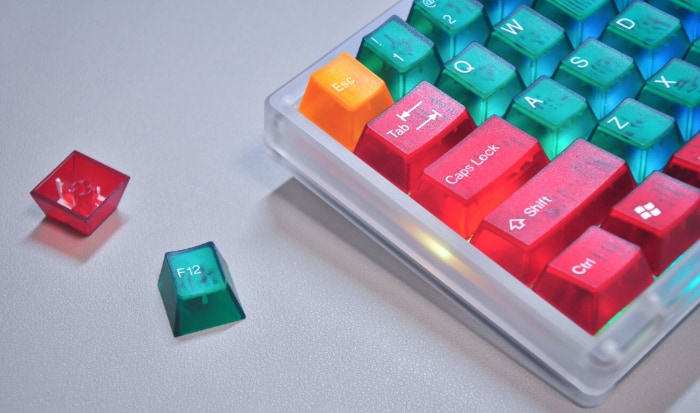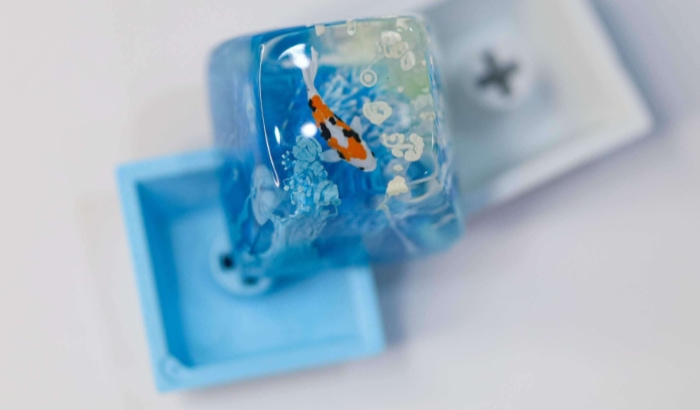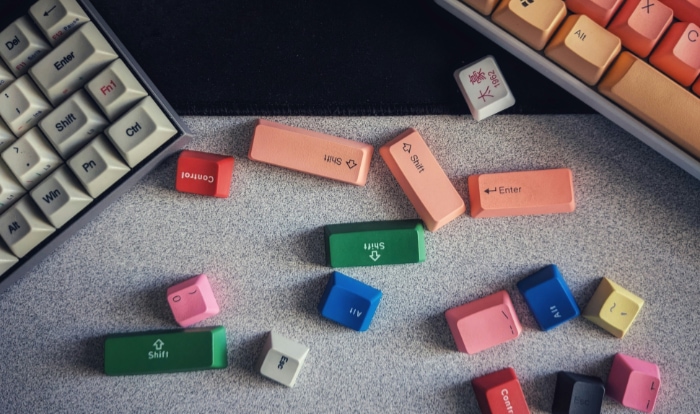How to Clean Keycaps on Your Mechanical Keyboard

Mechanical keyboards have become a staple for both avid gamers and productivity-focused professionals, offering a tactile and personalized typing experience. Central to their appeal are the keycaps, the individual caps on each key that we interact with every day.
However, regular use inevitably leads to the accumulation of dust, debris, and oils from our fingers, affecting not only the keyboard’s appearance but also its functionality. Regular cleaning of these keycaps is more than just a cosmetic concern; it’s a vital practice that ensures the longevity and optimal performance of your mechanical keyboard.
Identifying the Type of Keycaps
Mechanical keyboard enthusiasts often emphasize the importance of knowing your keycap material. The most common materials are ABS (Acrylonitrile Butadiene Styrene) and PBT (Polybutylene Terephthalate), each with unique characteristics and cleaning requirements.
Recognizing the type of material your keycaps are made of is essential for applying the correct cleaning methods and ensuring the durability of the keycaps.
Keycap Materials and Their Cleaning Requirements
ABS Keycaps:
- Characteristics: ABS keycaps are known for their smooth texture and flexibility. They are lighter and less expensive, making them a common choice for many manufacturers.
- Cleaning Requirements: ABS keycaps are prone to developing a shiny appearance with prolonged use due to wear. Gentle cleaning methods are recommended to avoid hastening this process. Mild detergents and soft cloths are ideal for ABS keycaps.
PBT Keycaps:
- Characteristics: PBT keycaps are denser and more durable than their ABS counterparts. They have a slightly textured surface and are more resistant to shine and wear.
- Cleaning Requirements: PBT keycaps can withstand more rigorous cleaning methods. They are less likely to be damaged by stronger cleaning solutions, but it’s still advisable to avoid harsh chemicals.
Tips for Identifying Keycap Material
- Texture and Shine: Feel the texture of the keycaps. PBT keycaps usually have a grainy texture, while ABS keycaps are smoother. Also, look for signs of shine; ABS keycaps tend to get shiny with use, whereas PBT keycaps maintain their matte finish longer.
- Sound Test: Tap the keycaps lightly. PBT keycaps typically produce a more solid and lower-pitched sound compared to the higher-pitched sound of ABS keycaps.
- Manufacturer Information: Check the manufacturer’s specifications for your keyboard or keycap set. Most manufacturers specify the type of material used in their product descriptions.
- Weight Test: If you have a precise scale, you can weigh the keycaps. PBT keycaps are generally heavier than ABS keycaps of the same size.
- Water Test: If you’re still unsure, you can perform a water test. PBT keycaps usually sink in water, while ABS keycaps tend to float due to their lower density. Be sure to dry the keycap thoroughly after the test.
Preparing for Cleaning
A successful and safe cleaning process for keycaps begins with proper preparation. Having the right tools and materials at hand and setting up a suitable workspace are crucial steps.
This preparation ensures that the cleaning process is both efficient and effective, minimizing the risk of damage to your keycaps or keyboard.
Necessary Tools and Materials for Cleaning Keycaps
- Keycap Puller: This tool is essential for safely removing keycaps from your keyboard. There are wire and plastic variants, with wire pullers being gentler on the keycaps.
- Cleaning Solutions: Depending on the material of your keycaps, you may use mild dish soap or specialized keycap cleaning solutions. For ABS keycaps, it’s best to use gentler solutions to prevent wear.
- Soft Cloth: A microfiber cloth is ideal for wiping keycaps. It’s soft enough to prevent scratches and effective in removing dust and oils.
- Soft Brush: A soft-bristled brush or an old toothbrush can be used to gently scrub the keycaps, especially for removing ingrained dirt.
- Bowl or Container: You’ll need a container for soaking keycaps if you opt for a deep cleaning method.
- Distilled Water: If you plan to soak your keycaps, using distilled water can prevent water spots and mineral buildup.
- Towel or Drying Rack: After cleaning, you’ll need a space to lay out the keycaps to dry. A towel or a rack can ensure they dry evenly and quickly.
Safety Precautions and Workspace Preparation
- Disconnect the Keyboard: Always disconnect your keyboard from the power source to prevent any electrical hazards.
- Clean Workspace: Ensure your workspace is clean and free of clutter. This helps in keeping track of all keycaps and tools, and prevents accidental spills or mishaps.
- Ventilation: If you’re using any chemical cleaners, ensure good ventilation in your cleaning area to avoid inhaling fumes.
- Gentle Handling: Handle keycaps with care to avoid breaking the stems or causing cracks, especially when using the keycap puller.
Removing the Keycaps

Removing keycaps from a mechanical keyboard is a delicate process that requires precision and care. Proper removal not only preserves the integrity of the keycaps but also ensures the underlying switches are not damaged.
This step-by-step guide provides a clear approach to safely remove keycaps, tailored for both novices and experienced users.
Step-by-Step Guide to Safely Remove Keycaps
- Position the Keycap Puller: Align the keycap puller so that it grips the edges of the keycap. If using a wire puller, ensure it hooks securely under the keycap. For plastic pullers, make sure the prongs are positioned on opposite sides of the keycap.
- Gently Apply Upward Pressure: Once the puller is in place, apply gentle and even pressure upwards. Avoid jerking or twisting motions, as these can damage the keycap stems or the switch underneath.
- Remove the Keycap Slowly: As the keycap begins to lift, continue applying steady pressure until it pops off. Be patient and increase the force gradually if the keycap is resistant.
- Handle Larger Keys with Extra Care: For larger keys like the spacebar, shift, or enter keys, extra caution is needed. These keys often have stabilizers that require more careful detachment. Gently wiggle these keycaps side-to-side as you apply upward pressure to release them from the stabilizers.
- Repeat for All Keycaps: Continue this process for each keycap. It’s advisable to start from one corner of the keyboard and work your way across to avoid missing any keys.
Handling Tips to Prevent Damage
- Avoid Excessive Force: Never use excessive force when removing keycaps. If a keycap feels particularly tight, reposition the puller and try again gently.
- Mind the Stabilizers: Be mindful of keys with stabilizers. These require a bit more finesse and gentle wiggling to remove without damaging the stabilizer mechanism.
- Keep Keycaps Organized: As you remove each keycap, place them in an organized manner. This will simplify the process of reassembling the keyboard later.
- Inspect for Damage: After removing each keycap, quickly inspect it and the switch underneath for any signs of damage. This can prevent further issues during reassembly.
- Clean the Keyboard Base: With all keycaps removed, it’s a good opportunity to clean the keyboard base. Gently brush away any debris and dust from the surface and between the switches.
Cleaning Methods for Keycaps
Maintaining the cleanliness of keycaps is essential for the longevity and optimal performance of your mechanical keyboard. There are two primary methods for cleaning keycaps: basic cleaning for regular maintenance and deep cleaning for removing ingrained dirt and stains.
Both methods have their specific processes and requirements, ensuring that whether your keycaps need a quick refresh or a thorough cleanse, you have the right approach at hand.
Basic Cleaning
Basic cleaning is ideal for daily or frequent maintenance to keep your keycaps looking and feeling fresh. This method involves dusting and light wiping, perfect for removing surface dirt and finger oils.
- Dusting: Begin by gently dusting the keycaps using a soft brush or compressed air. This removes loose dirt and debris that accumulates through regular use.
- Wiping with a Damp Cloth: After dusting, lightly dampen a microfiber cloth with water or a mild cleaning solution. Wipe each keycap individually, applying gentle pressure to remove surface oils and smudges.
- Choosing Cleaning Agents: For light cleaning, avoid harsh chemicals. Mild dish soap diluted in water works well, or you can use cleaning solutions specifically designed for electronics. Ensure the cleaning agent is gentle to avoid damaging the keycap material.
- Drying the Keycaps: After wiping, use a dry microfiber cloth to remove any moisture from the keycaps. Ensure they are completely dry before reattaching them to the keyboard.
Deep Cleaning
Deep cleaning is recommended for removing more stubborn dirt and stains. This method is more intensive and involves soaking, scrubbing, and thorough drying of the keycaps.
- Preparing the Cleaning Solution: Fill a bowl or container with warm water and add a few drops of mild dish soap. For heavier stains, you can use specialized keycap cleaning solutions, but ensure they are suitable for the material of your keycaps.
- Soaking the Keycaps: Place the removed keycaps in the cleaning solution. Allow them to soak for 30 minutes to an hour, depending on the level of dirt build-up.
- Scrubbing: After soaking, use a soft brush or toothbrush to gently scrub each keycap. Pay special attention to crevices and text on the keycaps to remove all dirt.
- Rinsing: Once scrubbed, rinse the keycaps under running water to remove any soap residue. It’s important to ensure all cleaning agents are thoroughly washed off.
- Drying Process: Dry the keycaps initially with a towel to remove excess water. Then, lay them out on a dry towel or a drying rack in a well-ventilated area. Allow them to air dry completely, which can take several hours. Avoid using heat sources for drying, as this can warp the keycaps.
Reassembling the Keyboard

After cleaning the keycaps, reassembling them onto the keyboard is the next crucial step. This process requires careful attention to ensure that each keycap is correctly placed and the keyboard is restored to its optimal functional state.
Proper reassembly not only enhances the keyboard’s aesthetics but also ensures that every keystroke is smooth and accurate.
Guidance on Correctly Placing the Keycaps
- Refer to a Layout Diagram or Photo: Before beginning, it’s helpful to have a reference for the keyboard layout. If you took a photo of your keyboard before disassembly, now is the time to use it. Alternatively, you can find a standard layout diagram for your keyboard model online.
- Start with the Larger Keys: Begin by placing the larger keys such as the spacebar, enter, shift, and backspace. These keys often have stabilizers that need to be carefully aligned. Gently press down on the keycaps until you feel them snap into place.
- Proceed with Alphanumeric Keys: Once the larger keys are in place, move on to the alphanumeric keys. Align the keycaps with their respective switches, ensuring the orientation is correct. For most keys, the text or symbols should be facing the user.
- Apply Even Pressure: As you place each keycap, apply even pressure to snap it onto the switch. You should hear a subtle click or feel the keycap secure itself onto the switch.
- Check for Alignment: After placing the keycaps, visually inspect the keyboard to ensure all keycaps are aligned properly and sitting at the same height.
Tips for Ensuring All Keys are Properly Seated and Functional
- Test Each Key: After reassembly, test each key to ensure it depresses smoothly and registers a keystroke. This can be done using a keyboard testing software or simply by typing in a text document.
- Adjust as Necessary: If a key feels off or doesn’t register, gently remove the keycap and reseat it, ensuring it’s properly aligned with the switch.
- Be Mindful of Keycap Profiles: Some mechanical keyboards use varying keycap heights and angles for different rows. Ensure that each keycap is returned to its correct position according to its profile.
- Avoid Forcing Keycaps: If a keycap doesn’t seem to fit, do not force it. Double-check its placement and orientation. Forcing a keycap can damage the stem or the switch.
- Final Inspection: Once all keys are tested and functioning correctly, do a final inspection of the keyboard to ensure everything looks and feels as it should.
Conclusion
Maintaining clean keycaps is an essential aspect of caring for a mechanical keyboard. Through the methods and steps outlined, users can effectively tackle both regular upkeep and more intensive cleaning tasks.
By correctly identifying keycap materials, preparing adequately for the cleaning process, and meticulously removing and cleaning the keycaps, the functionality and aesthetic appeal of the keyboard can be significantly enhanced. The reassembly phase, while requiring patience and attention to detail, ensures that each keycap is optimally placed for a seamless typing experience.
Regular cleaning not only prolongs the life of the keycaps but also contributes to a more hygienic and visually pleasing workspace. With these guidelines, keyboard enthusiasts can enjoy a clean, responsive, and well-maintained mechanical keyboard, which is not just a tool but a partner in both work and play.


